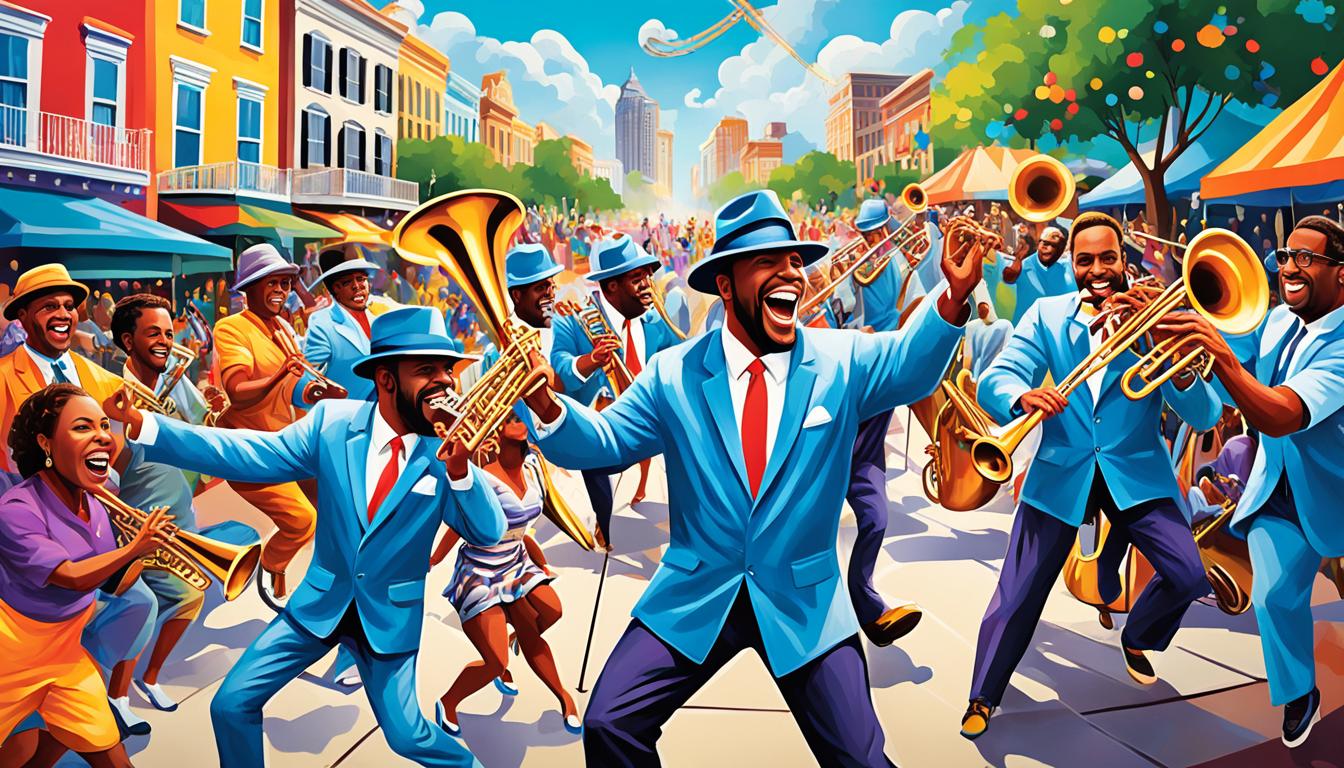Syncopate to the Beat: Experiencing Louisiana’s Jazz Culture
Louisiana is not just a place with great music. It’s the birthplace of jazz. This happened in New Orleans, at the state’s center. Here, a mix of different cultures created jazz, a genre loved worldwide.
Jazz in Louisiana is like a story. It starts with the beats in Congo Square. Then, it flows into the sounds of jazz bands in New Orleans. This music takes people on a journey through Louisiana’s heart and soul.
But it’s not just New Orleans that’s special. Other places in Louisiana added their own music. For example, Baton Rouge, Lafayette, and Lake Charles brought blues, Cajun, and zydeco to life. Shreveport is also important, adding its touch to country, rockabilly, and blues.
Many immigrants came to Louisiana, each with their own music. This mixed with local sounds, making Louisiana’s music truly special. It’s a place where all these different sounds meet, creating a unique vibe.
Key Takeaways:
- Louisiana is the birthplace of jazz, with New Orleans as its epicenter.
- Different regions of Louisiana, such as Baton Rouge and Lafayette, have influenced various genres like blues, Cajun, and zydeco music.
- Shreveport played a vital role in shaping country music, rockabilly, and the blues.
- Louisiana’s jazz culture is a unique mix of African, European, Caribbean, and immigrant influences.
- Immerse yourself in Louisiana’s jazz culture through cultural tours, experiencing the syncopated beats and vibrant performances that define this musical tradition.
The Birthplace of Jazz: New Orleans and Congo Square
New Orleans is known as the birthplace of jazz. Its 19th-century culture and lively social scene set the stage for this new music genre.
A key spot for jazz’s beginning was Congo Square, found in the Treme neighborhood. Enslaved Africans came here on Sundays to sing, dance, and worship, adding a rich rhythm to the air.
The mix of African, European, and Caribbean cultures at Congo Square shaped the essence of New Orleans jazz. The beats and melodies there were the core of this unique sound.
“Congo Square was the meeting of Africa and Europe…. The music which surged out of Africa [and] Europe blended together to form the perfect vehicle for the blues, jazz, and all of the other music which would follow.” – Wynton Marsalis
Through a blend of African rhythms, European instruments, and Caribbean tunes, jazz was born. This mix brought together structure with improvisation, giving birth to a vibrant, new kind of music.
The Influence of Congo Square
Congo Square was more than a place for music and dance. It was a hub for cultural sharing and creativity. This exchange formed the basis of the American music future.
The blending of African beats and European tunes created a music form loved by all. This special sound laid the foundation for jazz, gospel, Rhythm & Blues, and rock and roll.
Congo Square is crucial in cultural history, symbolizing resilience, freedom, and creativity. It’s remembered as a place where music blossomed despite challenges.
Today, Congo Square still stands, honoring the birth of jazz and New Orleans’ culture. It celebrates the artistic bravery of enslaved Africans, leaving a powerful historic legacy.
This historic place is full of life and memories, showing its vital role in New Orleans’ culture. Here, the spirit and sounds of jazz’s beginnings are alive, inspiring all who visit.
The Elements of New Orleans Jazz

New Orleans jazz is famous for its energetic and dance-friendly style. We will explore the main features that make this music stand out. These elements combine to create a music genre that is both unique and fascinating.
Brass Bands
New Orleans jazz is closely linked to brass bands. Bands feature trumpets or cornets, clarinets or saxophones, and trombones. The powerful sounds of these instruments provide the heart of New Orleans jazz, setting the stage for its lively rhythm.
Improvisation
Improvisation is key in New Orleans jazz. It means making up music as you play, allowing musicians to show their own style. This spontaneous creativity adds a special touch to each performance, making the music fresh and exciting every time.
Syncopation
Syncopation is what gives New Orleans jazz its catchy and lively rhythm. It focuses on the unexpected accents and offbeats. This unique rhythm pattern invites people to move and dance, making it perfect for social events and celebrations.
Through brass bands, improvisation, and syncopation, New Orleans jazz keeps enchanting people globally. Each part plays a role in the genre’s distinct sound and feel. This reflects the rich culture and history of the city, making the music truly special.
Conclusion
Louisiana’s jazz music is a key part of the state’s culture, deeply rooted in its music. Jazz started in New Orleans and grew with help from places like Baton Rouge and Lafayette. This state has been a big player in jazz across North America.
To dive into Louisiana’s jazz culture, take a cultural tour. This adventure will showcase the many music traditions and famous tunes of the area. You’ll get to hear the special beats and amazing performances that make up Louisiana’s jazz world.
Walk through the buzzing streets of New Orleans or visit Baton Rouge and Lafayette’s music spots. These are places where Louisiana’s jazz spirit comes alive. By joining a cultural tour, you’ll have the chance to feel the magic of Louisiana jazz. Let its enchanting sounds lead you through the fascinating story of this musical legacy.







